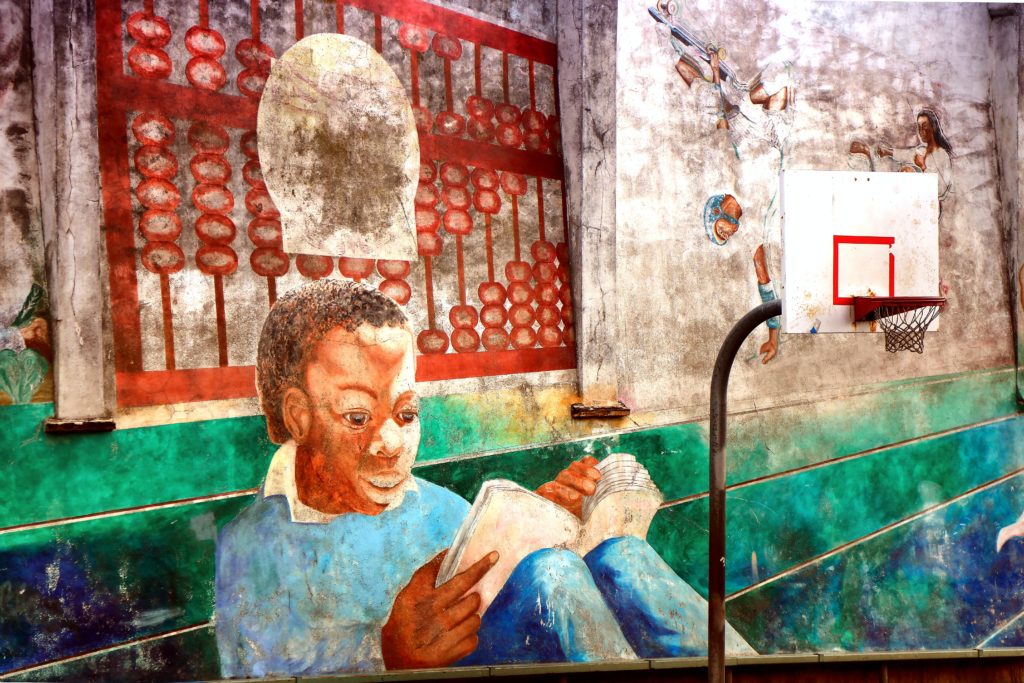Advancing Governors’ 2021 Priorities Through the Arts

This photo was taken outdoors in San Francisco near a school with a basketball court. The photo shows a vibrantly colored mural featuring a young person reading. The young person is depicted seated and leaning against an abacus. The photographer frames the mural as the focal point in the image and also includes a portion of the basketball court for visual perspective.
Photo credit: Alexander Hipp on Unsplash
Each year, Education Commission of the States tracks and analyzes trends in education priorities from governors’ State of the State addresses. In 2021, the repercussions of the COVID-19 pandemic were a common refrain among governors. Of the 42 states included in this special report, at least 32 governors addressed issues related to funding, 21 addressed student achievement and interrupted schooling and 18 addressed physical and mental health of students, teachers and school workers.
While no governors included arts education in their addresses, here we offer three considerations for how arts education can advance state education priorities.
Leverage State and Federal Funding to Support Arts Education
It’s no surprise for many arts stakeholders that the federal Every Student Succeeds Act (ESSA) provides multiple opportunities for states to support the arts. While the fiscal situation for many states is better than predicted, Title IV-A funds through ESSA can continue to be tapped for safe remote, hybrid and in-person arts instruction, particularly for personal protective equipment that is specific to arts classrooms. The pandemic has caused states to re-evaluate school quality and success indicators in their state ESSA accountability plans. Arts education stakeholders may continue to look for opportunities for the arts throughout these changes and can look to states like Illinois as early leaders in this area.
The American Rescue Plan also designates more federal aid to K-12 schools as well as evidence-based summer enrichment and afterschool programs. Research demonstrates that summer learning opportunities that leverage community assets, balance academic and enrichment activities and are designed to meet the needs and interests of youths can provide the supports students need most. As governors have greater discretion to make funding choices related to these programs, arts and cultural groups can be important collaborators in offering these key ingredients for successful programming.
Identify Opportunities for Arts Education in State Responses to Interrupted Schooling
In addition to extending learning time and high-dosage tutoring, researchers emphasize differentiation and personalized learning, culturally relevant instruction, promoting student agency, reducing redundancy across subject areas and including real-world applications to support student engagement. Culturally relevant instruction requires educators to re-construct curriculum and adjust their teaching in ways that authentically reflect and honor students’ lives and cultures. Arts education alongside integrated approaches to learning — such as arts integration and STEAM — offer multiple pathways for states to pursue these recommendations.
In addition to changes to instruction, changes to assessment may offer new opportunities for arts education. Researchers emphasize the importance of contextualizing both learning and assessment to meet the specific needs of students. This includes assessment processes that are designed not only to identify gaps in learning, but also give educators real-time information on how to close those gaps. Arts educators are experienced in demonstrating how assessment can move beyond test scores to include work samples, teacher observations and other types of important data that educators can use to inform instruction. Schools may also consider adding variety to the ways that students are tested, such as using visual and performing arts as stimulus material or as a way for students to demonstrate what they know, in addition to traditional testing methods.
Support Student Health and Wellness Through the Arts
Student health and wellness considerations are perhaps the most dramatic shift in 2021 priorities. States are juggling logistics to keep students, educators and other school staff physically healthy, in addition to mitigating the mental and emotional toll of the pandemic, racism and other systemic inequities. State and district leaders are confronted with the reality that students have very different home lives and experiences that require re-prioritization of student mental and emotional wellness in the classroom.
Social and emotional interventions support student well-being, and as a result, improve academic outcomes and positively impact school culture and climate. The impact of arts education on students’ mental health and social and emotional skills has been top of mind for many educators and researchers pursuing a whole-child approach to education. Gloria Ladson Billings speaks to the need to “re-set” education and offers new ideas to center education around students and their cultures, including the “[integration] of body, mind and spirit.” Without considering the conditions of students’ lives, particularly mental and emotional health, states risk exacerbating inequities for students, particularly for Black students and students impacted by socioeconomic disadvantages.
Governors’ 2021 priorities reflect new challenges and opportunities in education policy. While arts education didn’t make the short list of explicit priorities, students and policymakers alike benefit when the arts are a part of the education policy conversation — children have opportunities to engage in learning to increase their skills in the arts, while state leaders have additional pathways to meet their broader education policy goals.



